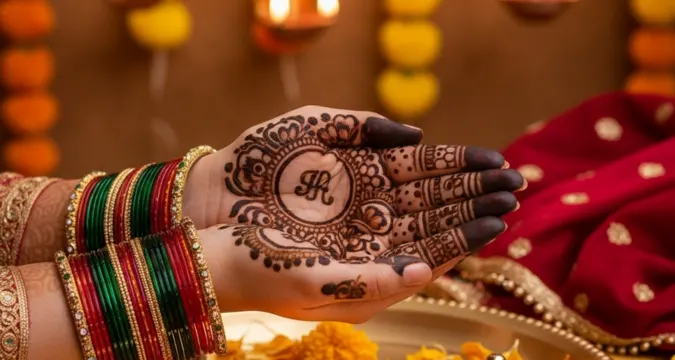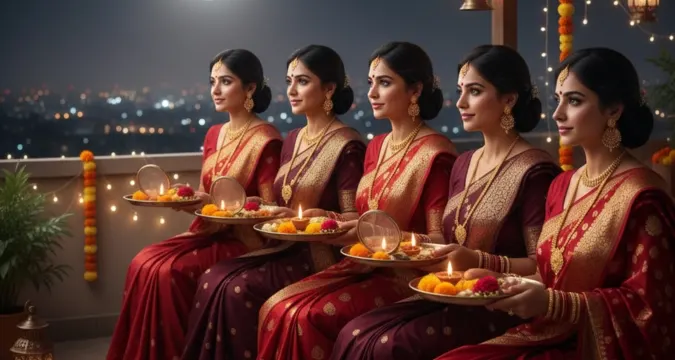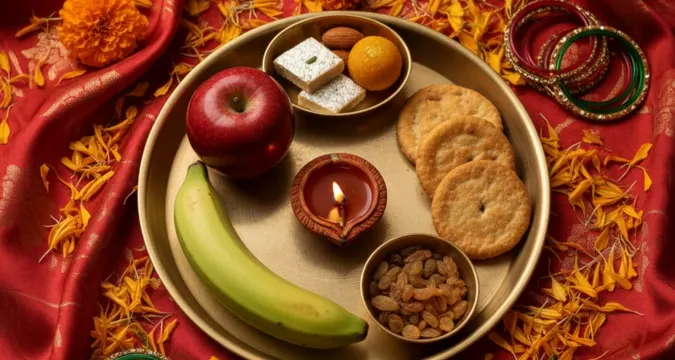Karwa Chauth 2025: Puja, Moonrise & Modern Traditions
Karwa Chauth has been a classical rite of celebrating the love, faith, and devotion to a marriage in Indian culture. Millions of married women in India fast all day once in a year just to be able to contribute to the personal welfare and prosperity of their husbands. However, India is changing and this time-honored practice is bound to transform, match the beat of life in the new century, accept equality and to redefine love in our new era.
Karwa Chauth is not merely a ritual festival, in 2025, it is a manifestation of Indian living culture in which tradition and modernity have been walking hand in hand.

Karwa Chauth 2025: Date, Tithi, and Important Information
The date set by the Hindu lunar calendar of Karwa Chauth in 2025 is October 8, 2025. This festival is on the Chaturthi Tithi (fourth day) of Krishna Paksha month of Kartik.
Key Details for 2025:
- Date: October 8, 2025 (Wednesday)
- Chaturthi Tithi Appears: 06:28 AM on October 8, 2025.
- End of Chaturthi Tithi: 04: 43 AM on October 9, 2025.
- Puja Muhurat (Evening Time): 05:47 PM -07:04 PM (Approx.)
- Time of the moonrise: Approximately, 08:16 PM (Depends on the geographical location a little)
Women start fasting by waking up early in the morning before the sun comes out and end this fasting only when they can see the moon in the sky at night and pour offering water (arghya) and prayers to the life of their husband.
The Karwa Chauth background: Love, Faithfulness and the Power of Vow
Karwa Chauth has its origin in the mythological narratives that bring out love, sacrifice and endurance. The best known of these is the tale of Queen Veeravati who was so faithfully devoted to her husband as to revive him in death.
The legend opines that Queen Veeravati fainted in the process of her fast and the brothers sabotaged her by displaying a sight of a fake moon over a mirror to win her confidence in breaking the fast. As soon as she had taken her fast, her husband was killed. Being grieved, Veeravati had to rely on Goddess Parvati, who revived the life of her husband. The narrative was an expression of undying fidelity in the marriage leading to the tradition of fasting till the actual appearance of the moon.
Karwa Chauth, in other stories, is also associated with Draupadi and Arjuna, or even Parvati-the goddess, and Shiva-the god, each confirming the importance of loyalty, strength, and protection by the Gods.
The Traditional Rituals: A Day of Discipline and Devotion
The Sargi Ritual
In pre-marriage, married women eat a pre-dawn meal called Sargi, prepared by their mothers-in-law. It usually comprises fruits, dry fruits, sweets and parathas. The word Sargi is equivalent to blessings and energy to survive the day-long fast.
The Day-long Fast
Women do not eat or drink after sunrise till moonrise. The fast is physical as well as spiritual, an ordeal of will and love.
The Puja and Evening Rituals
The women attend parties in the evening adorned in bright traditional garments such as red or in-maroon sarees or suits which revolve around their marital happiness. They attend the Karwa Chauth ritual and read Karwa Chauth Katha and go round with the thali in a circle singing some traditional songs invoking blessings of Goddess Parvati.
When the moon rises, women see it obviously through a sieve, say prayers, and observe their husbands through the sieve. The husband then implies water or first bite of food to his wife after which she ceases to fast. Catching the emotional core of the festival, this scene is usually lit by moonlight and candles.
Karwa Chauth in India in other Parts
Most people refer to Karwa Chauth as part of North India but this nature of the festival has spread to states, they each have their local colors:
- Punjab and Haryana: The festivities here are the most exquisite, and the women are usually presented with a lot of gold, new garments, and skincare as part of worship. Festive candies and mehendi booths adorn the markets.
- Uttar Pradesh and Madhya Pradesh: Rituals are traditionally very strong and the customs of fasting are highly observed.
- Rajasthan: Women tend to dress their palm with a traditional print of the moon and the name of their husband and the colorful dishes used by the women are also adorned with folk songs.
- Maharashtra and Gujarat: In other cities it is increasingly popular bringing together North Indian ceremonies with those of the locals.
- South India: Karwa Chauth is not a traditional celebration, however the contemporary generation has adopted and embraced the whole idea as an epitome of firm devotion toward marriage and their cultural heritage.
Karwa Chauth in New India: Love without Gender and Roles

Karwa Chauth has changed over the past ten years. What was a festival dominated by women is presently an event in which men are fasting on behalf of their wives, couples are fasting alongside their wives and even young ladies are fasting showing hope of having a blessed future mate.
Working women in metropolitan urban centers juggle practices and time around fasting and meetings between commuting or attending to work. Technology also took part in the tradition: virtual pujas, livestreaming of the time of a moonrise, and digital recipes of Sargi have allowed making the festival available all over the world.
The soul stays the same, however the prayer itself is a prayer of love, loyalty, and long-term friendship.
Scientific and Spiritual Views
It benefits wellness-wise since by fasting once a year, one may be more devoted and disciplined. According to Ayurveda, Karwa Chauth is a body/mind purification ritual. Relative lunar account of fasting is also observable in ancient Indian astronomy, which broadly associates human feelings with the cosmic patterns.
The fast is not concerned with deprivation, but rather touching on control of self, compassion, and bond. The moon, which is usually linked to female power (Chandra Tattva), is regarded as the breathless monitor of love- a universal icon in civilizations.
Fasting Policies and Puja Hacks 2025
For Women Observing the Fast:

- Sly starts the day with a light Sargi before the abandonment of the sun. Virtual steer clear of spicy or oily food that leads to dehydration.
- Never take caffeine that augments thirst.
- Partake of light-hearted exercises, meditation, or pious reading.
- Pujali, which includes diya, karwa (pot), sieve, sindoor, incense sticks, diya, prepared rice and sweets should be prepared.
- Wear clean and bright clothing, preferably customary red, pink or maroon.
- Pray to goddess Parvati and Lord Shiva and take prayer before the moonrise.
- Fast during the day and break the fast when you see the moon and carry out the rituals with your husband.
For Modern Couples:
- In case of fasting for both partners, make sure that you remain hydrated and calm of mind.
- Track the moonrise with time using digital applications.
- Attend local yuas or online activities to convey the spirit of the festival, particularly when not in a family set-up.
After the Do’s and Don’t towards a Healthy Fast
Do’s
- Before daybreak, eat nutritious food.
- Sleep sufficient in the daytime.
- Keep your mind active by doing something good such as devotional music or reading.
Don’ts
- Overall avoid strenuous movement or heat exposure.
- Do not miss this Sargi meal–it gives the much needed energy.
You must not argue, or be on any emotional shoestrings, because Karwa Chauth is a day of peace and holiness.
Economic and Social Side of Karwa Chauth
Karwa Chauth has also turned into a cultural economy of its own. Although they originated in designer thalis, themed mehendi parties and festival sales all qualify as the festival triggering local business, mainly in North India. During this season, jewellery, cosmetic, ethnic fashion, and online gifting are recording a sharp rise in sales.
Its social media has brought it more into the limelight making Karwa Chauth an issue of culture. The millions of people who follow them (celebrities who share their fasting photos and rituals) transform personal religious sacrifice into a commonplace online festivity.
Karwa Chauth Beyond Religion: The sign of comitance

Currently, Karwa Chauth varies across the religious borders and is a common cultural experience. The interfaith couples and the global Indians view it to be a happy, grateful holiday of ingratitude and love and emotional bonding as opposed to a ritual compulsion.
It is no longer considered so patriarchal, but, quite on the contrary, a mutual exchange of love–one, both partners are aware of the significance of devotion, emotional resilience, spiritual integration.
The Eternal Moon of Love
India is gradually becoming more digital and modern and the festivals such as the Karwa Chauth are a reminder of the emotional ties that bind our culture together. No matter how small a town the setting of the festivity is, or how big metropolis the balcony of some apartment complex is, the sight of a fasting lady looking at the moon will continue to be among the most poetic imagery in India.
Karwa Chauth is still changing–nevertheless, it is eternal. It is not merely about a husband starving; it is about beliefs in a love that is everlasting, dedication, perseverance, and that advertising that even a moon makes it rain down its blessings upon.








